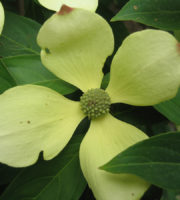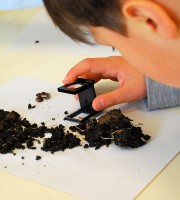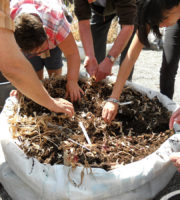The Botanical Garden has a collection of tropical plants that in the winter months is hospitalized in a portion of the greenhouse is not accessible to the public. Some examples are in foster care to some of Bergamo city schools and the province during the winter months.
Since 2008 during the summer tropical potted plants become part of the Tropicarium, whose structure is made of bamboo and other plant material of the land art artist Alejandro Guzzetti.
The exhibition is divided here usually to continents and highlights aspects of the plants related to plant relationship with man and to their importance in the life of every day, from food plants in the textile, technology, medicine, dry cleaners, cosmetic and ornamental.
A part of the tropical plant collection is dedicated to Ayurvedic tradition, medicine used in India since ancient times and even widespread more in Western medicine today. It is a very complex medical system that includes aspects of prevention and care in a holistic view.
Plants that have many uses for healing purposes are: Withania somnifera, shrub that grows in tropical and warm-temperate zones, whose active ingredients are mainly concentrated in the roots and berries and leaves, with anti-inflammatory, immunomodulatory, anti-oxidants; Adhatoda vasica, evergreen shrub distributed in various parts of India, especially in the Himalayan foothills up to 1000 m above sea level and is used to treat bronchitis, asthma, fever and jaundice for antispasmodic properties of the roots and leaves that contain a alkaloid and an essential oil; Bacopa monneri, herbaceous plant with succulent leaves present in the wetland habitats of low altitude, is very popular in India for properties that aid memory and intellectual abilities and revitalize the sense organs; Elettaria cardamomum, better known as cardamom, is native to India and the same ginger family, Zingiberaceae. In addition to the Ayurvedic medicine, the dried seeds benefits were also known to the Greeks and Romans as a remedy for gastrointestinal disorders; Piper nigrum, the pepper, is the fruit of a vine native to southern India and also now extensively farmed in tropical climate in many countries and is used since ancient times as a food seasoning as a remedy; Terminalia arjuna, tall tree up to 60 meters typical of India and Malaysia which produce construction timber, is wanted for the bark that contains stimulants for the heart used in many places in the Tibetan Ayurvedic medicine; Tamarindus indica, tamarind, is a tree grows in East Africa but widespread in many tropical areas of Asia and Latin America for food and ornamental purposes, locally recognized as a remedy for certain stomach or digestive problems and against toothache.







